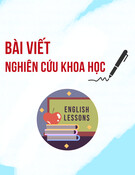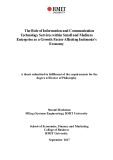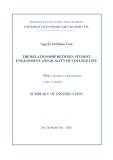
VĂN HÓA https://jst-haui.vn
Tạp chí Khoa học và Công nghệ Trường Đại học Công nghiệp Hà Nội Tập 61 - Số 2 (02/2025)
82
NGÔN NG
Ữ
P
-
ISSN 1859
-
3585
E
-
ISSN 2615
-
961
9
UTILIZING “BAAMBOOZLE” TO INCREASE STUDENT
ENGAGEMENT IN EMI CLASSES
ỨNG DỤNG “BAAMBOOZLE” NHẰM TĂNG SỰ THAM GIA CỦA SINH VIÊN
TRONG LỚP HỌC GIẢNG DẠY CHUYÊN NGÀNH BẰNG TIẾNG ANH
Nguyen Viet Nga1,*
DOI: http://doi.org/10.57001/huih5804.2025.040
ABSTRACT
In recent days, the use of information technology in teaching has been widely popularized in various educational contexts, es
pecially in English medium of
instruction (EMI) classes. Among the many
software and information technology tools applied in education, the “Baamboozle” platform is known to be able to
support teachers in promoting students’ interest in learning and student engagement in lessons. The current study aimed to investigate the effe
ctiveness of
using “Baamboozle” in enhancing student participation in EMI classes at a public university in Vietnam. Specifically, this st
udy was conducted over ten weeks
and used research tools including a questionnaire survey of 50 students and classroom
observation. This study provides important reference information for
those educators, researchers, and teachers who are searching for or interested in utilizing information technology applicatio
ns in language teaching in particular
and in education in general, especially for those teaching EMI subjects.
Keywords: Technology, EMI classes, “Baamboozle”, student engagement.
TÓM TẮT
Trong thời gian gần đây, việc sử dụng công nghệ thông tin trong giảng dạy đã được phổ biến rộng rãi trong nhiều bối cảnh giáo dục khác nhau, đặc biệ
t là
trong các lớp học giảng dạy chuyên môn bằng tiếng Anh (EMI). Trong số rất nhiều các phần mềm, công cụ công nghệ thông tin được áp dụng trong giáo dụ
c,
nền tảng “Baamboozle” được biết đến có khả năng hỗ trợ giáo viên thúc đẩy sự hứng thú học tập và sự tham gia của sinh viên vào bài học. Nghiên cứu hiện tạ
i
nhằm tìm hiểu hiệu quả của việc sử dụng “Baamboozle” trong việc tăng cường sự tham gia của sinh viên vào các lớp học EMI tại một trường đại học công lập củ
a
Việt Nam. Cụ thể, nghiên cứu này thực hiện trong mười tuần và sử dụng các công cụ nghiên cứu bao gồm bảng câu hỏi điều tra 50 sinh viên và việc quan sát lớ
p
học. Kết quả cho thấy việc sử dụng “Baamboozle” cải thiện đáng kể trong sự tham gia của sinh viên, thể hiện rõ nhất ở sự hào hứng với hoạt động trên nền tả
ng
và tương tác tăng lên trong các buổi học EMI. Bài báo cung cấp nguồn tài liệu tham khảo quan trọng cho các nhà giáo dục, nhà nghiên cứu và giả
ng viên quan
tâm đến việc tìm kiếm và sử dụng các ứng dụng công nghệ thông tin trong giáo dục nói chung và giảng dạy tiếng Anh nói riêng, đặc biệt là với người dạ
y các
môn chuyên ngành bằng tiếng Anh.
Từ khóa: Công nghệ, lớp học EMI, “Baamboozle”, sự tham gia của sinh viên.
1School of Languages and Tourism, Hanoi University of Industry, Vietnam
*Email: nganv@haui.edu.vn
Received: 02/01/2025
Revised: 10/02/2025
Accepted: 27/02/2025
1. INTRODUCTION
The integration of Information and Communication
Technology (ICT) into education has revolutionized
teaching and learning processes, enhancing interaction
and engagement among students and teachers. Saud et
al. [1] said that ICT plays a crucial role in modern
classrooms, offering innovative tools that foster
collaboration, motivation, and active participation. In
English language learning, gamification platforms have
gained popularity because they have the potential to





















